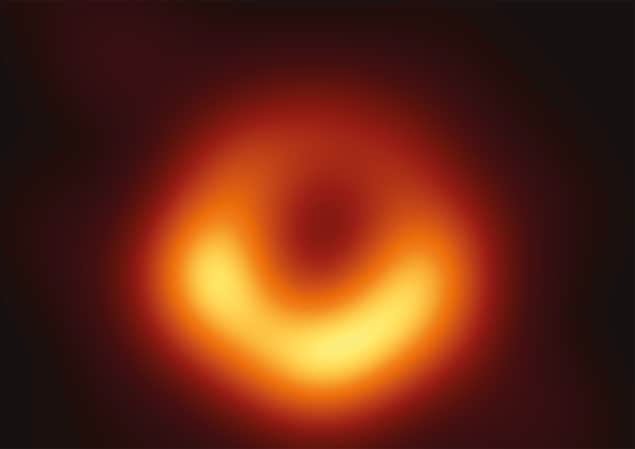
For the last two decades, we’ve been living through a “golden age” in astronomy. We’ve mapped fluctuations in the cosmic microwave background, spotted thousands of extrasolar planets and measured the accelerating expansion of the universe. And then, in 2016, gravitational waves were detected for the first time, opening an entire new window on the cosmos, including the sight of colliding black holes and neutron stars.
But those breakthroughs have been matched – and possibly even eclipsed – by the first-ever image of a black hole, which were released earlier this week.
Likened by some to the eye of Sauron from Lord of the Rings, this instantly iconic image – which will grace the cover of the May 2019 issue of Physics World magazine – shows the glowing disc of hot matter surrounding the event horizon of the supermassive black hole M87* at the heart of the Messier 87 galaxy. The dark region at the centre is the “shadow” of the black hole, roughly three times larger than the (invisible) event horizon. Predicted by general relativity, the shadow is significant as it’s a feature of the horizon, while its size and shape gives clues to the mass and spin of the black hole.
But the images of M87* aren’t just scientifically significant. Obtaining them was an experimental tour-de-force too. As the smallest angle that a telescope can resolve is inversely proportional to its diameter, you’d need a dish as big as the Earth to see a black hole, the largest of which would fit snugly inside our solar system.
Astronomers’ solution was the Event Horizon Telescope – a network of 8 radio telescopes, whose signals are combined using very-long-baseline interferometry. Atomic clocks had to be installed at each location to perfectly “time stamp” the images, while data banks from the telescopes had to be flown to a common data centre for processing.

Portrait of a black hole
The ensuing image, which hit the headlines and went viral on social media, was also a triumph of data analysis. Astronomers observed the black hole over four days in April 2017, generating a staggering five petabytes of data they’ve spent the last two years crunching through, with Katherine Bouman – who’s soon moving to Caltech – given main billing by many news reports. Their heroic efforts have paid off, transforming the event horizon from a purely mathematical concept, scrawled on blackboards and written in lecture notes, to a measurable, physical entity.
Astronomers are now hoping for even better images of M87* by adding more telescopes to the EHT. And we could soon see Sagittarius A* – the black hole at the heart of our Milky Way. It’s nearer than M87* but harder to resolve, changing over minutes rather than days.
To find out more, I urge you to explore the research behind the image, which appears in a series of free-to-read papers in the Astrophysical Journal (875 L1-5), published by the Institute of Physics (which publishes Physics World) on behalf of the American Astronomical Society. Within two days of publication, the papers had been read and downloaded more than 376,000 times.
Our view of the cosmos will truly never be the same.
• For more on how the black hole was imaged, listen to the latest episode of the Physics World Weekly podcast.



